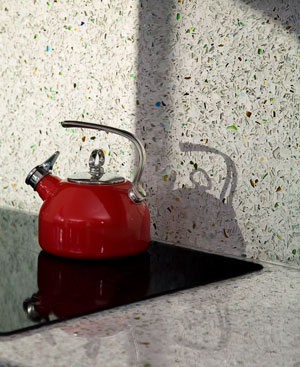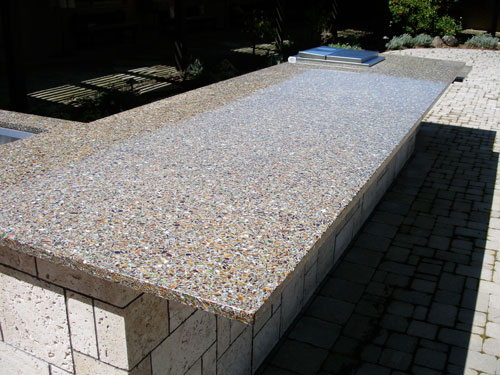Landfill Treasures: Recycling Glass from Trash to Upscale Interior Surfaces
Clearly Sustainable
The inherent properties of glass make it a strong sustainable solution for the design professional. Recycled glass surfaces meet high performance criteria for quality and durability. The checklist for selecting the best recycled glass surface includes the following:
- Ease of maintenance: A recycled glass surface can be cleaned with a damp cloth, liquid soap or mild detergent. Used as a countertop it requires periodic sealing like granite and other stone. For surfaces that do not need to be water repellent a zero VOC sealant can be applied, for most countertops, low VOC sealants should be used. Surfaces will require occasional waxing for enhanced stain resistance, however, glass by its nature is vitreous and non-staining.
- Heat resistance: A resin-based surfaces such as quartz and solid surfaces can withstand only up to 300 degrees F however, recycled glass surfaces can withstand temperatures of over 600 degrees F making them superior surfaces for kitchen counters. The process of combining the thermal properties of cement with the thermal properties of glass creates a product with superior thermal resistance.vii
 |
A subtle, multi-colored glass counter created from a mix of glass bottles contribute to the modern design of this kitchen. Photo courtesy of Polycor Vetrazzo Inc. |
- Durability: Recycled glass surfacing is similar in density to granite. It has greater strength than concrete or marble. Some recycled glass surfaces have 10-year warranties.
- Scratch Resistance: Recycled glass surfaces have been tested and found superior to marble or solid surfaces for scratch resistance and they are comparable to stone surfaces. As mentioned above, glass is highly resistant to scratches falling between a 6 to 7 on the Mohs scale.
- Stain Resistance: The porosity of recycled glass surfaces is better than concrete and similar to marble because glass itself is an inert substance impervious to stains. Although most of the surface is comprised of glass, regular sealing will extend performance.
- Colorfastness: These counters can be used near windows, skylights and outdoors. Recycled glass surfaces with cement binders are impervious to UV light, unlike polyester resin binders that may be prone to discoloration.
- Standard Fabrication: Recycled glass surfaces use the same equipment and techniques as those used for natural stone. Fabricators who work with stone find it easy to fabricate recycled glass surfaces however Manufacturer training and certification is key. As with any high-end material, the fabricator should measure thrice to cut once. Because of the unique quality of the glass mosaic pieces, the installer may need to cement inlays to fit. Recycled glass panels are typically 1’ 1/4 thick and do not require a plywood substrate. A variety of edge profiles, are available and skilled fabricators can work with the client to determine which profile is best for their project. Typically same skilled craftsmen who work with granite, etc. can expertly fabricate recycled glass surfaces. Standard tools like CNC machines and gantry saws can be used to install counters. Training and certification are important so look for brands that support their network of fabricators.
- Food safety: Some recycled glass surfaces are tested and certified by NSF for food safety and can be used in numerous commercial applications.
- Freeze Thaw cycle: These surfaces can be used outdoors as cladding for outdoor furniture and wall surfaces. When installed outdoors during the winter season in cold climates, the product should be covered up.
 |
This outdoor kitchen at Sunset Magazine’s headquarters in Menlo Park, California was clad with recycled glass surfaces. Proper sub tops will prevent cracking. Photo Courtesy of Andy Ferguson |
CASE STUDY Customer Service – Innovative recycled Glass Counter Says Green Nicole Sheahan, LEED AP Interior Designer for Charter House Innovations, chose recycled glass counter as an accent for the Cary, North Carolina McDonald’s restaurant because it was “ the customers first experience with the store and symbolized sustainable practices.” This restaurant is the first LEED Gold McDonald’s in North Carolina and as of one of only three LEED certified locations in the country. The store utilizes roof top skylight tubes which provide natural lighting to 92 percent of the restaurant and save 24 percent more energy than a standard McDonald’s. Rapidly renewable resources such as kirei board, bamboo, sunflower seed board, and wheat board are used throughout the store’s seating and decor. Approximately 550,000 gallons of water will be saved every year by utilizing high efficiency restroom and kitchen fixtures, combined with exterior water-saving features. Regional construction materials were used to boost the local economy and reduce pollution created by excess transportation. Many of the building materials feature high recycled content, including cotton batt insulation, metal studs, gypsum wall board, decor elements, wall coverings, tile, counter tops and dining surfaces. To improve indoor air quality, all products were manufactured with no additional urea-formaldehyde. Low VOC paints, adhesives, sealants and coatings were used and all upholstery vinyl is PVC free. Other interior features included integrated waste/recycling centers and customer-accessible recycling areas. Environmentally friendly cleaning products are also used at this location. Lesson Learned This was one of the first locations where Charter House had specified a recycled glass counter and their challenge was to utilize this material at the fullest potential while taking into consideration the limitations on the given material. The designers used the recycled glass counter on the front service counter―the one spot in the restaurant everyone gets to see when they order their food. They also used it in the restrooms as vanity counter tops. They wanted to have the greatest impact on the customer using this material that so clearly told a story about recycling. By putting the material in such a noticeable location the installation had to be flawless with great attention paid to seeming and transitions from slab to slab. They recommend that the designer have good communications with their installer and clearly specify and communicate to the installer, the edges, seams and the intersections of this surface with other building materials. The designers at Charter House are excited to find innovative materials like recycled glass surfaces that they can share with their customers on green projects. |









